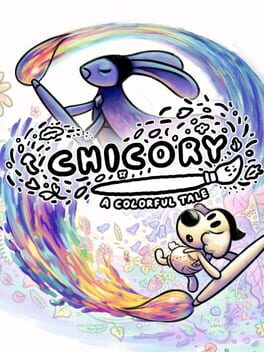The core premise of Chicory: A Colorful Tale—repainting color into a world after the previous painter (a.k.a. wielder) puts aside her brush—is not one which sustains a 10-20 hour experience which makes up the game. Players need not paint every square inch of Picnic Province, but the itch to do so fuels the player when each subsequent screen is in black and white. So, to save time and effort, perhaps don't do it... or continue so, because the end gif you receive for beating the game is a cute little memento of the effort sustained (or not) throughout. This basic gameplay design of painting can certainly become dull by the third chapter, and it did... Yet, Greg Lobanov's writing for the world's inhabitants and the growing emotional beats which build chapter by chapter lend a foundation to Chicory which keeps its simplicity from truly crumbling. Each creature—mammal, insect, amphibian, bird, and whatnot—has a personality of some sort, and although most don't carry much weight on their own, when the player meets more and more and learns of their hopes, fears, and creativity there's a true sense of care and attention that imbues itself. These furry, cute, weird people make the player want to keep on painting in their homes and environments, to see them find delight or a slimmer of optimism as color returns. Pickle, a friendless fennec fox, was one I especially found endearing (if not too close to heart). This empathetic sensation that runs throughout Chicory is assisted by the gameplay which uses the player's creativity, however limited it may be, to find meaning within their situation; as the player solves puzzles, crafts art, and defeats bosses, the conversations had and the creative decisions made by the player reach below a surface level depth that can seem quite silly in hindsight, yet it lingers.
I didn't completely fall for Chicory. The simplistic design of it all still bores down with noticeable effects. But, despite some repetition and long-winded puzzle chambers, the heart and soul of the world and its characters remain the game's best attributes. Chapter 5 and 10 have two unforgettable moments: the former at its boss as the protagonist faces the boss's depression, and the latter in its forced return to Luncheon in a debilitating manner. Both force an endurance of the deepest pit of emotional apathy toward creative endeavors, and as someone who often doesn't follow through with his aspirations for want of emotional stability, these moments hit harder than I could've thought. It's these moments—among many—that land at just the right place in capturing the artistic themes of Chicory, where the gameplay still fails to engage when not aiming toward innovation in either new puzzles or boss encounters.
Is this one of my favorites of 2021? No, probably not. I'm glad others found it more successful, but for the 17 hours I took to 100% the game, only about half of that felt earned. Still, that doesn't discount how much of Chicory I loved even when it was not so fun or memorable. The art design, Lena Raine's soothing music, and those fucking art lessons I sucked at have the marks of a game whose developers loved every moment they were allowed to craft such a unique experience. That is what I'll carry from such a personal game.
I didn't completely fall for Chicory. The simplistic design of it all still bores down with noticeable effects. But, despite some repetition and long-winded puzzle chambers, the heart and soul of the world and its characters remain the game's best attributes. Chapter 5 and 10 have two unforgettable moments: the former at its boss as the protagonist faces the boss's depression, and the latter in its forced return to Luncheon in a debilitating manner. Both force an endurance of the deepest pit of emotional apathy toward creative endeavors, and as someone who often doesn't follow through with his aspirations for want of emotional stability, these moments hit harder than I could've thought. It's these moments—among many—that land at just the right place in capturing the artistic themes of Chicory, where the gameplay still fails to engage when not aiming toward innovation in either new puzzles or boss encounters.
Is this one of my favorites of 2021? No, probably not. I'm glad others found it more successful, but for the 17 hours I took to 100% the game, only about half of that felt earned. Still, that doesn't discount how much of Chicory I loved even when it was not so fun or memorable. The art design, Lena Raine's soothing music, and those fucking art lessons I sucked at have the marks of a game whose developers loved every moment they were allowed to craft such a unique experience. That is what I'll carry from such a personal game.
